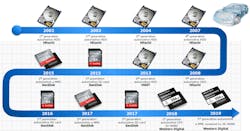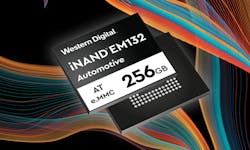Western Digital is a well-known name in storage technology, but many may not know about its OEM products or those targeting the automotive market (Fig. 1). The latest automotive storage devices are needed to address a range of applications, from digital clusters to V2X communications. ADAS systems and self-driving vehicles have massive storage requirements, and they require devices that can stand the heat… and cold.
1. Western Digital has a long track record in the automotive space. It acquired Hitachi and San Disk many years ago.
The new iNAND AT EM132 (Fig. 2) is just the latest in a string of high-reliability, high-capacity storage solutions designed for rugged applications. The e.MMC chip has a 256-GB capacity using 64-layer, TLC NAND flash technology.
2. Western Digital’s iNAND AT EM132 e.MMC chip stores 256 GB of data using multilayer TLC NAND flash technology.
The iNAND AT EM132 provides advanced health monitoring as well as thermal-management support. The chip also supports robust power management. Developers can utilize automatic or manual read refresh. Its data-retention specifications exceed the JEDEC standards for this type of storage. The IATF16949-certified, AEC-Q100-compliant chip adheres to the ISO26262 NAND flash Safety Mechanisms guidelines. PPAP L3 documentation is available.
This is the first e.MMC chip to take advantage of the multilayer, TLC NAND flash technology. The 256-GB capacity is impressive. And it incorporates enterprise-class ECC support as well as alpha particle protection and power protection.
About the Author
William G. Wong
Senior Content Director - Electronic Design and Microwaves & RF
I am Editor of Electronic Design focusing on embedded, software, and systems. As Senior Content Director, I also manage Microwaves & RF and I work with a great team of editors to provide engineers, programmers, developers and technical managers with interesting and useful articles and videos on a regular basis. Check out our free newsletters to see the latest content.
You can send press releases for new products for possible coverage on the website. I am also interested in receiving contributed articles for publishing on our website. Use our template and send to me along with a signed release form.
Check out my blog, AltEmbedded on Electronic Design, as well as his latest articles on this site that are listed below.
You can visit my social media via these links:
- AltEmbedded on Electronic Design
- Bill Wong on Facebook
- @AltEmbedded on Twitter
- Bill Wong on LinkedIn
I earned a Bachelor of Electrical Engineering at the Georgia Institute of Technology and a Masters in Computer Science from Rutgers University. I still do a bit of programming using everything from C and C++ to Rust and Ada/SPARK. I do a bit of PHP programming for Drupal websites. I have posted a few Drupal modules.
I still get a hand on software and electronic hardware. Some of this can be found on our Kit Close-Up video series. You can also see me on many of our TechXchange Talk videos. I am interested in a range of projects from robotics to artificial intelligence.





